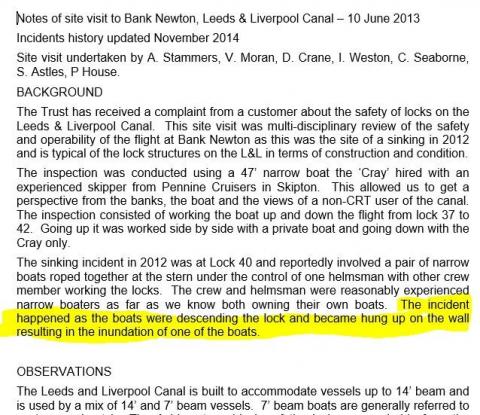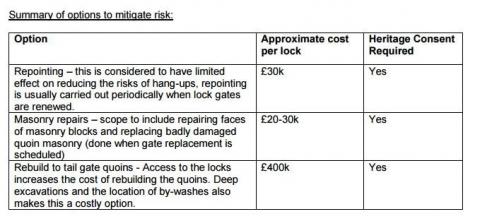C&RT's contradictory statements on lock safety
February 2017 - Allan Richards looks in more detail at the contradictory statements being made by the Canal & River Trust about the safety of the Bank Newton locks on the Leeds and Liverpool Canal – now the subject of intense scrutiny after the charity settled - out of court and at considerable expense - a case brought against them by Ken Churchill after his vessel sank in lock 40 on the flight.
It is not difficult to take issue with C&RT's North West Waterways manager, Chantelle Seaborn’s claim: “The Trust has always taken the view that Lock 40 is not defective” (Lock safety battle goes back to HSE - 13/2/2017).
Based on C&RT’s own minimum safety standards and its reports produced for HSE, it is simply untrue.
More believable, is that the Trust settled out of court because they knew that Mr Churchill would win his case.
Quite simply, after being fined for not producing documents that showed a high number of similar ‘hanging up on lock wall’ incidents on the Bank Newton flight, the game was up for C&RT.
What is so disturbing in this sorry saga, is that C&RT failed to disclose its minimum safety standards to Ken Churchill, just as they failed to disclose those minimum standards to HSE when it became involved.
The incident happened on 10 June 2013 but not once has C&RT admitted that its minimum safety standards should ensure that lock wall hang ups never occur. Instead, the Trust has attempted to place the blame on ‘boater error’.
For those not familiar with C&RT’s minimum safety standards, the one applicable states ‘Lock chambers and gates are free of protrusions / indentations that could snag boats. Gates to be fendered’.
This standard was one of several initiatives introduced to prevent further loss of life following the sinking of ‘Drum Major’ with four fatalities in a lock near to the one in which Ken Churchill's boat, Patafea Pecosa, sank.
It’s not as if C&RT deny that the boat hung up on the lock wall. In its first report for HSE into the incident (in the form of notes of a site visit carried out some 17 months after the incident), C&RT states: ‘The incident happened as the boats were descending the lock and became hung up on the wall resulting in the inundation of one of the boats’.
Whilst the notes are unsigned those who undertook the site visit (to which the notes refer) included Chantelle Seabom (NW Waterways Manager), Tony Stammers (Head of Health and Safety) and their boss, Vince Moran (Operations & Asset Management Director).
Nobody thought fit to inform HSE, via the report, that the lock chamber was defective as, self-evidently, it failed to conform to C&RT’s own minimum safety standards. Instead the report dismissed the sinking as ‘boater error’.
To his credit, HSE’s Howard Whittaker expressed unhappiness with C&RT’s report. An HSE internal review (10/6/15 - some two years after the sinking) states: ‘Met with Chantelle Seaborn & Tony Stammers from the Trust. Put our concerns to them. Principally that this was not a fanciful risk, it involved potential fatalities to vulnerable members of the public, people could not be relied upon to mitigate the risk by following good boating practice, if they knew what that was, or to react appropriately in an emergency situation (i.e. serious wall hang up), and there is a documented history of previous incidents and near misses involving wall and other hang ups on the flight ….’
The meeting resulted in a second report (Lock 40 Boat Incident – Report for HSE by Tony Stammers - 26 October 2015).
This report detailed how risk of wall hang ups on the Bank Newton flight could be mitigated. It provided three ‘engineering options’ with costs estimated at between 20k and 400k per lock.
However, it made a case for taking no action whatsoever. Again, no mention was made of C&RT’s own minimum safety standards.
Sadly, despite C&RT’s minimum safety standards suggesting that its locks will be kept to a ‘hang up free’ standard, wall hang ups continue to occur.
The latest report from Julie Sharman (Director of Asset Management) to C&RT’s board details three ‘infrastructure related’ incidents of boats hanging up in locks.
Leaving aside the cilling of a boat due to a leaking bottom gate, the other two incidents directly relate to C&RT’s failure to adhere to its own minimum safety standards. The report blames one incident on a bulge (i.e. a protrusion) in a lock wall. The other is blamed on a boat catching under a ‘defective coping stone’ (i.e. an indentation).
Instead of ignoring the existence of a minimum safety standard introduced to prevent loss of life, would it not be better for C&RT to bite the bullet?
Either the Trust needs to make its locks compliant with its own standard or, alternatively, state why the standard, which was introduced in 2008, is not being met and introduce alternative measures to mitigate the risk.
As for Mr Stammers, one should ask why he still refuses to acknowledge publicly that C&RT has locks on its system that fail to meet its self-imposed minimum safety standards.
Perhaps he is too busy trying to defend his idea of pawl stops which, if fully implemented, would hamper boaters attempts to prevent hang up emergencies in defective lock chambers turning into still more sinkings.
Photos: (Top) The Bank Newton site visit report, (Middle) Mitigation options considered but C&RT decided to take no action, (Bottom) Ken Churchill's boat which sank in lock 40 after catching on the lock wall.








